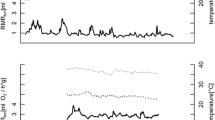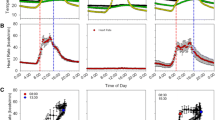Abstract
Wood lemmings (Myopus schisticolor) were captured during their autumnal migration in September and October. The animals were maintained at 12°C and under 12L:12D photoperiod. Basal metabolic rate and thermogenic capacity of the wood lemming were studied. Basal metabolic rate was 3.54 ml O2·g-1·h-1, which is 215–238% of the expected value. The high basal metabolic rate seems to be typical of rodents living in high latitudes. The body temperature of the wood lemming was high (38.0–38.8°C), and did not fluctuate much during the 24-h recording. The high basal metabolic rate and the high body temperature are discussed with regard to behavioural adaptation to a low-quality winter diet. Thermogenic capacity, thermal insulation and non-shivering thermogenesis of the wood lemming displayed higher values than expected: 53.0 mW·g-1, 0.53 mW·g-1·C-1 and 53.2 mW·g-1, respectively. Brown adipose tissue showed typical thermogenic properties, although its respiratory property was fairly low, but mitochondrial protein content was high compared to other small mammals. The 24-h recording of body temperature and motor activity did not reveal whether the wood lemming is a nocturnal animal. Possibly, the expression of a circadian rhythm was masked by peculiar feeding behaviour. It is concluded that the wood lemming is well adapted to living in cold-temperature climates.
Similar content being viewed by others
Abbreviations
- BAT:
-
brown adipose tissue; bm, body mass
- BMR:
-
basal metabolic rate
- C :
-
conductance
- Cox:
-
cytochrome-c-oxidase
- HP:
-
heat production
- HPmax :
-
maximum heat production
- M :
-
metabolism
- NA:
-
noradrenaline
- NST:
-
non-shivering thermogenesis
- NSTmax :
-
maximum non-shivering thermogenesis
- RMR:
-
resting metabolic rate
- RQ:
-
respiratory quotient
- T a :
-
anibient temperature
- T b :
-
body temperature
- T lc :
-
lower critical temperature
- UCP:
-
uncoupling protein
- vO2 :
-
oxygen consumption
- vO2 max :
-
maximum oxygen consumption
References
Aschoff J (1962) Spontane lokomotorische Aktivität. Handb Zool, vol VIII, part 11, pp 1–74
Batzli GO (1989) Responses of small mammalian herbivores to low-quality diets (abstract). 5th Int Theriol Congr, Rome
Björnhaug G (1989) Adaptation of the hindgut of small herbivores (abstract). 5th Int Theriol Congr, Rome
Bondrup-Nielsen S, Ims RA (1988) Demography during a population crash of the wood lemming, Myopus schisticolor. Can J Zool 66:2442–2448
Bradley SR, Deavers DR (1980) A re-examination of the relationship between thermal conductance and body weight in mammals. Comp Biochem Physiol 65:465–476
Böckler H, Steinlechner S, Heldmaier G (1982) Compete cold substitution of noradrenaline-induced thermogenesis in the Djungarian hamster, Phodopus sungorus. Experientia 38:261–262
Calder A, King JR (1974) Thermal and caloric relations of birds. In: Farner DS, King JR (eds) Avian biology, vol IV. Academic Press, New York London, pp 259–413
Cannon B, Nedergaard J (1985) Biochemical mechanisms of thermogenesis. In: Gilles R (ed) Circulation, respiration, and metabolism. Springer, Berlin Heidelberg, pp 502–518
Ellison GTH, Skinner JD (1991) Seasonal energy requirements and thermoregulation of growing pouched mice, Saccostomus campestris (Cricetidae). Int J Biometeorol 35:98–102
Erkinaro E (1973) Short-term rhythm of locomotor activity within the 24 h period in the Norwegian lemming, Lemmus lemmus, and water vole, Arvicola terrestris. Aquilo 14:46–58
Erkinaro E (1989) Length of intestine in some voles and lemmings (abstract). 5th Int Theriol Congr, Rome
Feist DD, Morrison PR (1981) Seasonal changes in metabolic capacity and norepinephrine thermogenesis in the Alaskan red-backed vole: environmental cues and annual differences. Comp Biochem Physiol 69:697–700
Framstad E, Stenseth NC, Grodzinski W, Hansson L (1981) Analysis of the effect of temperature, weight and activity on the energy metabolism of microtine rodents. Acta Theriologica 26:431–448
Fredga K, Gropp A, Winking H, Frank F (1976) Fertile XX- and XY-type females in the wood lemming Myopus schisticolor. Nature 261:225–227
Fredga K, Gropp A, Winking H, Frank F (1977) A hypothesis explained the exceptional sex ratio in the wood lemming (Myopus schisticolor). Hereditas 85:101–104
Foster DO, Frydman ML (1978) Nonshivering thermogenesis in the rat. II. Measurements of blood flow with microspheres point to brown adipose tissue as dominant site of the calorigenesis induced by noradrenaline. Can J Physiol Pharmacol 56:110–122
Haim A (1987) Metabolism and thermoregulation in rodents: are these adaptations to habitat and food quality? S Afr Tydskr Wetenskap 83:639–642
Hayssen V, Lacy RC (1985) Basal metabolic rates in mammals: taxonomic differences in the allometry of BMR and body mass. Comp Biochem Physiol 81:741–754
Heldmaier G (1971) Zitterfreie Wärmebildung und Körpergrösse bei Säugetieren. Z Vergl Physiol 73:222–248
Heldmaier G (1975) Metabolic and thermoregulatory responses to heat and cold in the Djungarian hamster, Phodopus sungorus. J Comp Physiol 102:115–122
Heldmaier G, Buchberger A (1985) Sources of heat during nonshivering thermogenesis in Djungarian hamsters: a dominant role of brown adipose tissue during cold adaptation. J Comp Physiol 156:237–245
Heldmaier G, Böckler H, Buchberger A, Lynch GR, Puchalski W, Steinlechner S, Wiesinger H (1985) Seasonal acclimation and thermogenesis. In: Gilles R (ed) Circulation, respiration, and metabolism. Springer, Berlin Heidelberg, pp 490–501
Heldmaier G, Klaus S, Wiesinger H, Friedrichs U, Wenzel M (1989) Cold acclimation and thermogenesis. In: Malan A, Canguilhem B (eds) Living in the cold II. Colloque INSERM, Libbey, London Paris, pp 347–358
Heldmaier G, Steinlechner S (1981) Seasonal control of energy requirements for thermoregulation in the Djungarian hamster (Phodopus sungorus), living in natural photoperiod. J Comp Physiol 142:429–437
Heusner AA (1982) Energy metabolism and body size. I. Is the 0.75 mass exponent of Kleiber's equation a statistical artifact? Respir Physiol 48:1–12
Hissa R (1970) Calorigenic effect of noradrenaline in Norwegian lemming, Lemmus lemmus (L.) Experientia 26:266–267
Hissa R, Tarkkonen H (1969) Seasonal variations in brown adipose tissue in two species of voles and the common shrew. Ann Zool Fenn 6:444–447
Ilmén M, Lahti s (1968) Reproduction, growth and behaviour in the captive wood lemming, Myopus schisticolor (Lilljeb.). Ann Zool Fennici 5:207–219
Isotalo A (1971) Poron luonnonvaraisten rehukasvien ravintoarvosta. (The value of the natural fodder plants on the reindeer feeding). In: Annanpalo S (ed) The Research Society of Lapland Year Book XII. Pohjolan Sanomat, Kemi, pp 28–45
Jansky L (1973) Nonshivering thermogenesis and its thermoregulatory significance. Biol Rev 48:85–132
Kalela O (1963) Die geographische Verbreitung des Waldlemmings und seine Massenvorkommen in Finnland. In: Kalela O (ed) Beiträge zur Biologie des Waldlemmings, Myopus schisticolor (Lillj.). Arch Soc Vanamo 18 [suppl] Helsinki, pp 29–66
Kalela O, Oksala T (1966) Sex ratio in the wood lemming, Myopus schisticolor (Lilljeb.), in nature and in captivity. Ann Univ Turku 37A:1–24
Klaus S, Heldmaier G, Ricquier D (1988) Seasonal acclimation of bank voles and wood mice: nonshivering thermogenesis and thermogenic properties of brown adipose tissue mitochondria. J Comp Physiol B 158:157–164
Kleiber M (1961) The fire of life. Wiley, New York
Knight MH (1988) Thermoregulation in the largest African cricetid, the giant rat Cricetomys gambianus. Comp Biochem Physiol 89:705–708
Lechner AJ (1978) The scaling of maximal oxygen consumption and pulmonary dimension in small mammals. Respir Physiol 34:29–44
Lovegrove BG, Heldmaier G, Knight M (1991) Seasonal and circadian energetic patterns in arboreal rodent, Thallomys paedulcus, and a burrow-dwelling rodent, Aethomys namaquensis, from Kalahari desert. J Therm Biol 16:199–209
Lynch GR (1973) Seasonal changes in thermogenesis, organ weights, and body composition in the white-footed mouse, Peromyscus leucopus. Oecologia 13:363–376
McNab BK (1980) On estimating thermal conductance in endotherms. Physiol Zool 53:145–156
McNab BK (1986) Food habits, energetics, and the reproduction of marsupials. J Zool (Lond) 208:595–614
Merritt JF, Zegers DA (1991) Seasonal thermogenesis and bodymass dynamics of Clethrionomys gapperi. Can J Zool 69:2771–2777
Myllymäki A, Aho J, Lind EA, Tast J (1962) Behaviour and daily activity of the Norwegian lemming, Lemmus lemmus (L.) during autumn migration. Ann Zool Soc Vanamo 24:1–31
Nicholls DG, Cunningham SA, Rial E (1986) The bioenergetic mechanisms of brown adipose tissue thermogenesis. In: Trayhurn P, Nicholls DG (eds) Brown adipose tissue. Edward Arnold, London, pp 52–85
Novikov GA (1941) Ecology of the wood lemming on the peninsula Kola (in Russia). Zool Z 20:626–631
Packard GC (1968) Oxygen consumption of Microtus montanus in relation to ambient temperature. J Mammal 49:215–220
Pasanen S (1971) Seasonal variations in interscapular brown fat in three species of small mammals wintering in an active state. Aquilo 11:1–32
Prins HHT (1982) Why are mosses eaten in cold environments only? Oikos 38:374–380
Rafael J, Hüsch M, Stratmann D, Hohorst H-J (1970) Mitochondrien in braunem und weissem Fettgewebe: Struktur, Enzymprofil und oxidative Phosphorylierung. Hoppe-Seyler's Z Physiol Chem 351:1513–1523
Saarela S, Hissa R, Pyörnilä A, Harjula R, Ojanen M, Orel M (1989) Do birds possess brown adipose tissue? Comp Biochem Physiol 92:219–228
Saarela S, Keith JS, Hohtola E, Trayhurn P (1991) Is the “mammalian” brown fat-specific mitochondrial uncoupling protein present in adipose tissue of birds? Comp Biochem Physiol 100:45–49
Sparti A (1990) Comparative temperature regulation of African and European shrews. Comp Biochem Physiol 97:359–363
Sparti A (1992) Thermogenic capacity of shrews (Mammalia, Soricidae) and its relationship with basal rate of metabolism. Physiol Zool 65:77–96
Steinlechner S (1980) Photoperiodische Kontrolle der Thermogenesekapazität beim dsungarischen Zwerghamster Phodopus sungorus (Pallas). Dissertation, JW Goethe Universität, Frankfurt
Torre JC de la, Surgeon JW (1976) Histochemical fluorescence of tissue and brain monoamines: results in 18 min using the sucrose-phosphate-glyoxylic acid (SPG) method. Neuroscience 1:451–454
Weathers WW (1979) Climatic adaptation in avian standard metabolic rate. Oecologia 42:81–89
Wunder BA (1985) Energetics and thermoregulation. In: Tamarin RH (ed) Biology of New World Microtus. American Society of Mammalogists, pp 170–180
Wunder BA, Dobkin DS, Gettinger RD (1977) Shifts of thermogenesis in the prairie vole (Microtus ochrogaster). Oecologia 29:11–26
Author information
Authors and Affiliations
Rights and permissions
About this article
Cite this article
Saarela, S., Hissa, R. Metabolism, thermogenesis and daily rhythm of body temperature in the wood lemming, Myopus schisticolor . J Comp Physiol B 163, 546–555 (1993). https://doi.org/10.1007/BF00302113
Accepted:
Issue Date:
DOI: https://doi.org/10.1007/BF00302113




